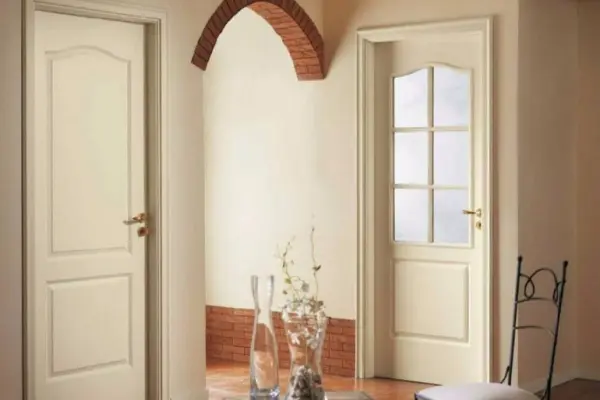The choice of material for interior doors determines the durability of the structure. In 2025, the price of a high-quality door unit ranges from $200-800. Materials for interior doors vary from budget-friendly MDF to premium solid wood, each with its own operational features and technical characteristics.
The modern market offers solutions for any budget. How to determine which interior door material is best? It depends on the operating conditions, budget, and aesthetic preferences. Buying high-quality interior doors means investing in comfort for decades.
It’s worth noting that a properly chosen door material can save up to 30% of the budget on subsequent maintenance and repairs.
Solid Wood: The Standard of Reliability
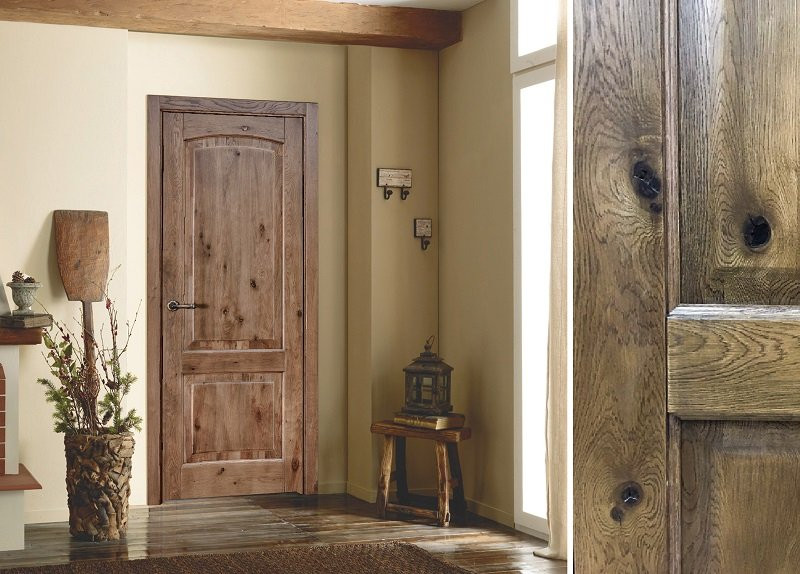 Solid wood interior doors remain the standard of quality. Oak provides sound insulation up to 28 dB with a 40 mm thick panel. Their service life is 30-50 years with proper care—like antique furniture passed down through generations.
Solid wood interior doors remain the standard of quality. Oak provides sound insulation up to 28 dB with a 40 mm thick panel. Their service life is 30-50 years with proper care—like antique furniture passed down through generations.
In my work with private clients, I often notice that customers overpay for solid wood without considering the room’s specifics. For a bedroom, high-quality MDF is sufficient. In a living room, solid wood creates the desired prestige, as the first impression is formed at the entry point.
Which is stronger, solid wood or MDF? Solid wood wins mechanically. However, it requires stable humidity of 45-55%, otherwise deformations and cracks are possible, according to GOST 475-2016 standards.
The main advantages of solid wood door panels include the following characteristics:
- Sound insulation of 25-30 dB for a standard 40 mm thick panel
- Durability—service life of 30-50 years with proper care
- Prestigious appearance and natural wood texture
- Possibility of restoration and surface reprocessing
- Eco-friendliness—E0 emission class for high-quality wood
These qualities make solid wood an ideal choice for prestigious rooms. Buying solid oak interior doors starts at $800 per panel, while pine starts at $400.
MDF Door Structures: A Universal Solution
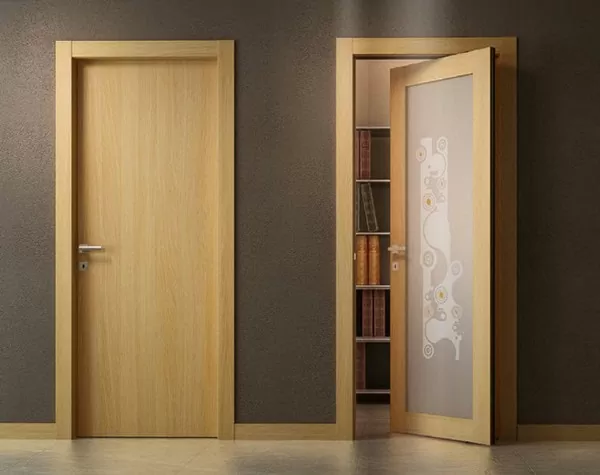 MDF interior doors hold a significant market share due to their versatility. The material is resistant to moisture and temperature fluctuations. The structure of an MDF interior door includes a softwood frame and a door panel filler—honeycomb, mineral wool, or wood shavings, depending on the price category.
MDF interior doors hold a significant market share due to their versatility. The material is resistant to moisture and temperature fluctuations. The structure of an MDF interior door includes a softwood frame and a door panel filler—honeycomb, mineral wool, or wood shavings, depending on the price category.
In one project last season, we installed MDF doors with eco-veneer in a children’s room. The result exceeded expectations: the door panel withstood active use without coating damage, and sound insulation improved by 20 dB.
Can MDF doors be installed in a bathroom? With high-quality moisture-resistant treatment, definitely yes. It’s worth noting that the edges require special sealing with moisture-resistant compounds. Ordering MDF interior doors with moisture-resistant coating costs $150-400.
Door Panel Finishes: Natural Veneer vs. Eco-Veneer
 Veneered interior doors mimic solid wood at an affordable price. Natural veneer is a thin wood slice, 0.5-3 mm thick. Door cladding with veneer-based materials gives a noble appearance but requires careful handling around moisture and direct sunlight.
Veneered interior doors mimic solid wood at an affordable price. Natural veneer is a thin wood slice, 0.5-3 mm thick. Door cladding with veneer-based materials gives a noble appearance but requires careful handling around moisture and direct sunlight.
How does veneer differ from eco-veneer? They involve fundamentally different production technologies. Eco-veneer is a polypropylene film with cellulose fibers and dyes, resistant to moisture and UV rays. Thus, eco-veneer is more practical for humid rooms, while natural veneer is more prestigious for living rooms and offices.
Eco-veneer interior doors last 15-20 years without losing their appearance. Finishing interior doors with eco-veneer can be 20-40% cheaper than natural veneer, depending on the manufacturer, with veneer door prices starting at $350 and eco-veneer doors at $200.
Modern design solutions often include creative approaches to space design, where doors play a key role in creating a cohesive interior.
Laminated and Enamel Interior Doors
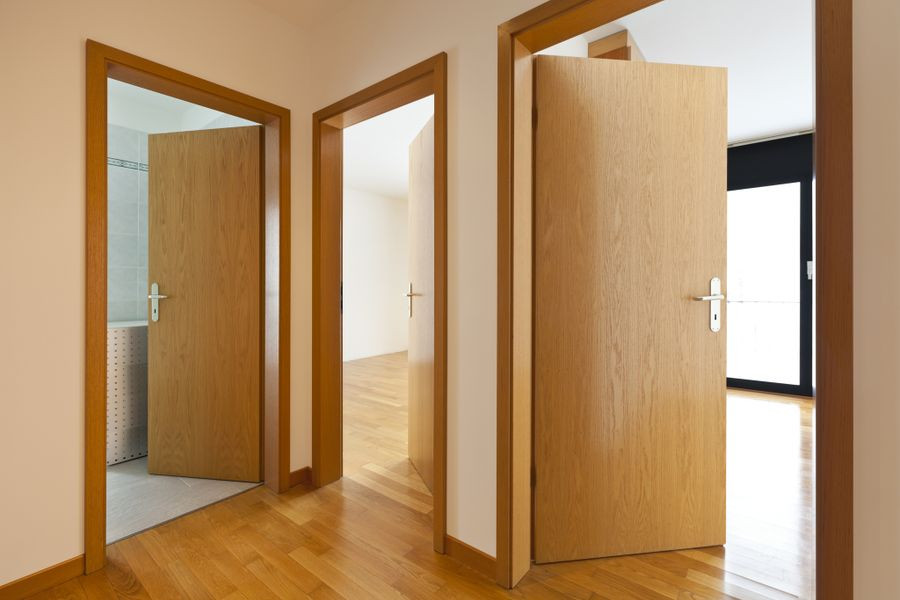 Laminated interior doors are a budget solution costing $100-250. The melamine film coating mimics various wood textures. The main drawback is the possibility of delamination at high humidity, making them unsuitable for bathrooms.
Laminated interior doors are a budget solution costing $100-250. The melamine film coating mimics various wood textures. The main drawback is the possibility of delamination at high humidity, making them unsuitable for bathrooms.
Enamel interior doors are coated with multiple layers of paint with intermediate sanding, resulting in a perfectly smooth surface. It’s known that enamel allows for any color from the RAL catalog, including vibrant and unconventional shades unavailable in natural materials.
In a recent project, a client chose laminated door structures for a wardrobe. Savings amounted to $800 compared to veneered alternatives. However, within a year, the coating began to peel in areas of frequent contact.
Choosing a coating for interior doors is like choosing a car: not only appearance and price matter, but also operating conditions, frequency of use, and the owner’s personal preferences.
Special Materials: Glass and Tsargovy Structures
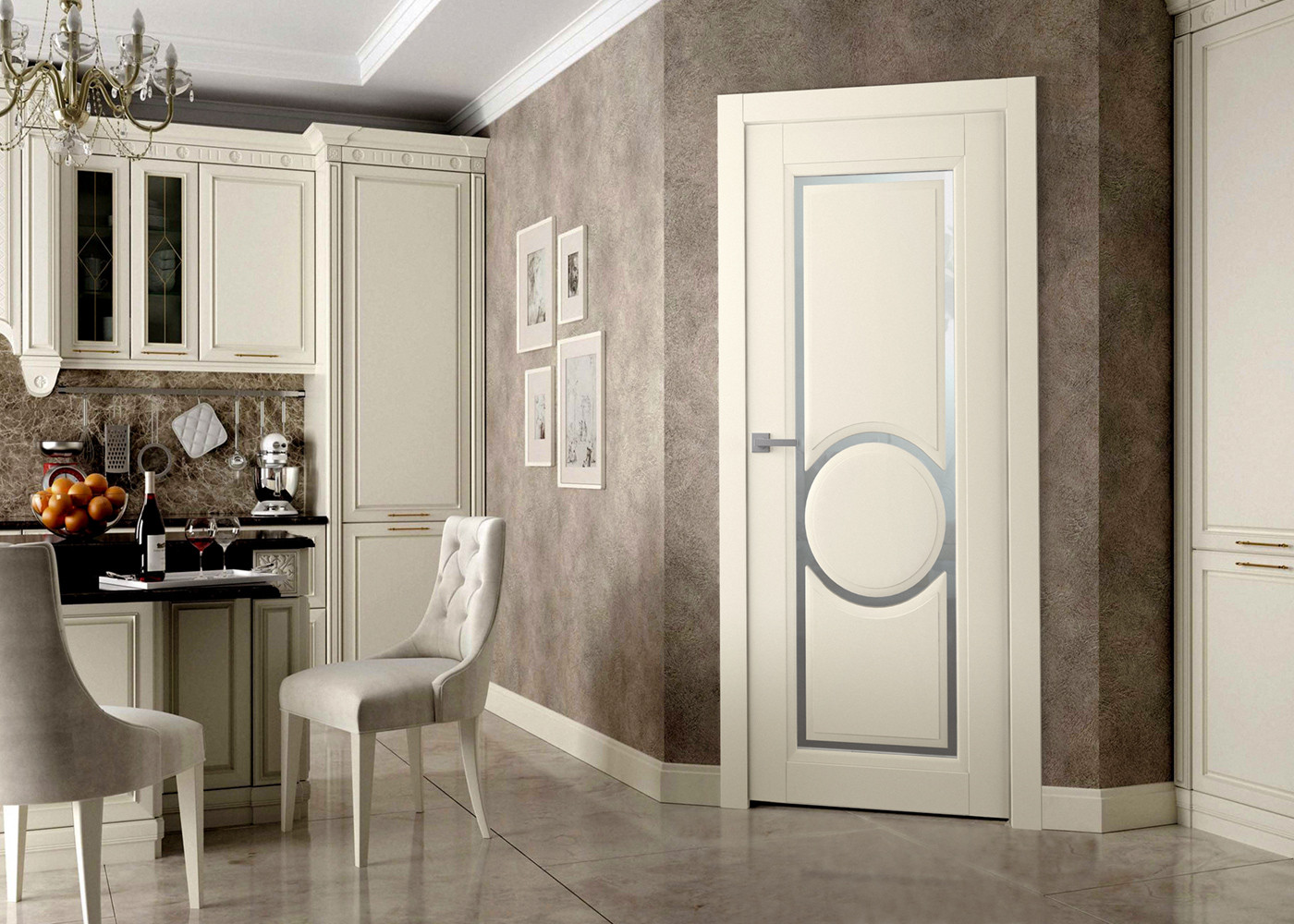 Glass interior doors made of tempered glass 8-12 mm thick are gaining popularity. They visually expand space and allow natural light to pass between rooms. For enhanced safety, triplex is recommended—a multilayered glass that doesn’t shatter into fragments upon breaking due to a protective film.
Glass interior doors made of tempered glass 8-12 mm thick are gaining popularity. They visually expand space and allow natural light to pass between rooms. For enhanced safety, triplex is recommended—a multilayered glass that doesn’t shatter into fragments upon breaking due to a protective film.
Tsargovy interior doors consist of individual elements assembled like a constructor. The door frame is made of solid wood, with panels made of MDF, and glass inserts are possible. Not always cheap, but practical for repairs.
Considering structural features, tsargovy door panels are easier to repair—individual elements can be replaced without dismantling the entire structure. In practice, I often notice that clients underestimate this advantage until the first major breakdown.
Comparative Table of Materials
For ease of selection, a comparative analysis of the main materials by key parameters is provided.
| Material | Price, $ | Service Life, Years | Sound Insulation, dB | Moisture Resistance | Application |
|---|---|---|---|---|---|
| Oak Solid Wood | 800-1500 | 30-50 | 25-30 | Medium | Living room, office |
| MDF with Veneer | 200-600 | 15-25 | 20-25 | Good | Bedroom, children’s room |
| MDF with Eco-Veneer | 150-400 | 15-20 | 18-22 | Excellent | Bathroom, kitchen |
| Laminated | 100-250 | 8-12 | 15-18 | Low | Storage, wardrobe |
| Enamel | 300-800 | 20-30 | 22-28 | Good | Any room |
| Glass | 400-1200 | 25-40 | 5-10 | Excellent | Office, studio |
The table shows that the choice depends on budget and operating conditions, with MDF with coating being the optimal solution for most cases.
In a recent project, a family replaced old chipboard doors with MDF with eco-veneer for just $1500. The result exceeded expectations: sound insulation improved by 15 dB, and the interior’s visual perception changed dramatically. Neighbors even asked if they had done a full renovation.
Quality of Hardware and Components
The best door materials require high-quality hardware. Hinges, handles, and locks affect the entire structure’s lifespan. German Blum or Italian Salice hinges last 15-20 years, while cheap analogs need replacement after 3-5 years.
Key elements of quality hardware include concealed hinges with closers, magnetic locks, and ergonomic handles. The cost of quality hardware accounts for 15-25% of the door’s price but extends its lifespan by 40-50%.
Modern Technologies and Quality Certifications
Interior doors, whose price accounts for innovative technologies, are equipped with antibacterial coatings and enhanced sound insulation. E1 certification guarantees formaldehyde content of no more than 10 mg/100g, while E0 ensures no more than 6.5 mg/100g. FSC confirms the eco-friendliness of wood.
According to European standards EN 14351-1, quality interior doors must meet requirements for strength, moisture resistance, and sound insulation. Bathroom doors require special moisture-resistant coating. Where to buy quality interior doors with appropriate certifications? From official dealers of European manufacturers.
How to choose a door material for a children’s room? Prioritize eco-friendliness and safety. MDF with eco-veneer or solid wood with natural coatings. Avoid chipboard and cheap laminates.
Which material is better for a bathroom interior door? Eco-veneer or enamel provide the necessary moisture resistance. Natural veneer requires additional protection.
In practice, I often notice that clients underestimate the importance of quality hardware. An expensive door with cheap hinges lasts less than a budget one with quality fittings.
When choosing a material, consider key factors affecting durability and comfort of use:
- Operating conditions—humidity, temperature, usage intensity
- Budget—not only the door’s cost but also installation and maintenance expenses
- Interior design—matching the room’s style and color scheme
- Functional requirements—sound insulation, light transmission, safety
- Eco-friendliness—especially important for children’s rooms and bedrooms
A thorough analysis of these factors will help avoid mistakes and choose the optimal solution.
For additional information on proper door installation, it’s recommended to study professional experiences and common installation mistakes.
Remember: a door is a long-term investment. Saving $100 today may lead to replacement in 5 years instead of 15.
Which Doors Last Longer
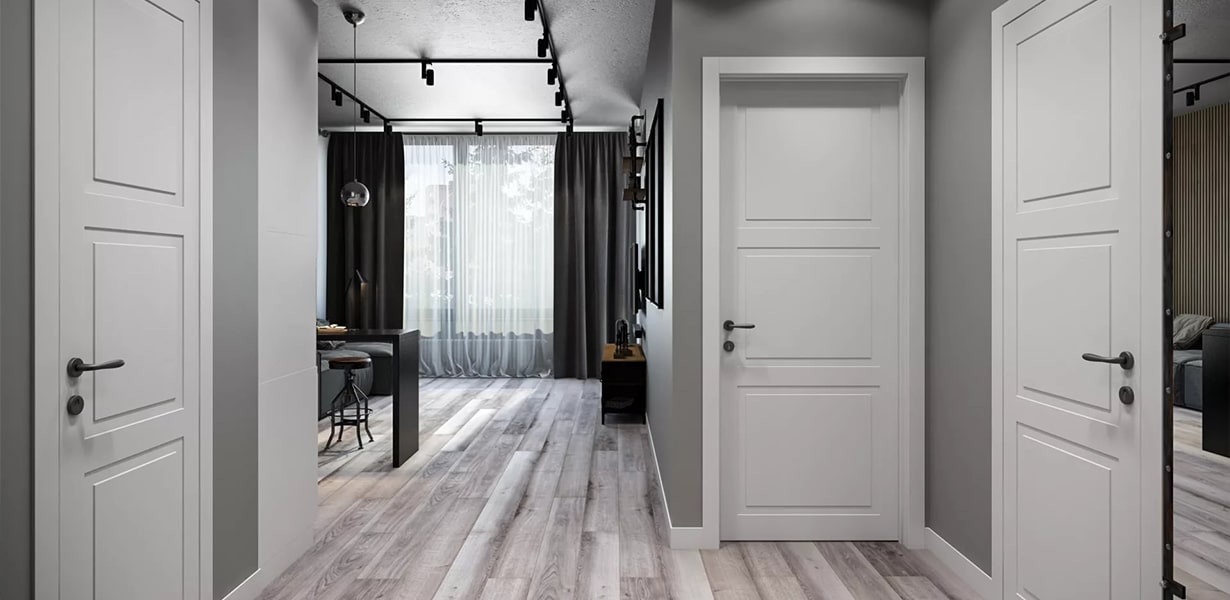 The service life depends on the material, manufacturing quality, and operating conditions. Solid wood with proper care lasts up to 50 years. MDF with quality coating lasts 15-25 years.
The service life depends on the material, manufacturing quality, and operating conditions. Solid wood with proper care lasts up to 50 years. MDF with quality coating lasts 15-25 years.
Which doors last longer in high-humidity conditions? Eco-veneer and enamel show the best results. Natural materials require special treatment.
Maintenance and Operation of Different Door Panels
Interior doors with installation require proper maintenance to preserve functionality. Each material has specific care requirements:
Solid Wood: Wipe with a dry cloth, wax polishing twice a year. Avoiding direct sunlight and humidity above 55% is critical to maintaining geometry per GOST 475-2016 requirements.
MDF with Coating: Wet cleaning without aggressive agents, temperature range of 18-24°C. Regular hinge lubrication doubles hardware lifespan.
Eco-Veneer: Simple care with soapy water. Resistant to household chemicals. No special treatment required—a key advantage for busy homeowners.
Enamel: Polishing with microfiber, avoiding abrasive agents. Scratch repair with special wax pencils costing $15-25.
Conclusion and Key Takeaways
Which material to choose for interior doors depends on the balance of budget, operating conditions, and aesthetic preferences. The best material for interior doors in most cases is MDF with quality coating: a combination of affordable price, durability, and practicality.
The key principles of selection are simple. Prioritizing hardware quality over panel material, matching operating conditions, and having quality certifications are the three pillars of a successful purchase. Affordable interior doors can be bought if all factors are considered and common beginner mistakes are avoided.
Investing in quality door structures pays off with durability and comfort. The average lifespan of modern panels is 15-25 years, making them one of the longest-lasting interior elements after load-bearing walls.
